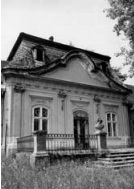Castle Karas in Horgoš was built for the members of the Karas family, after the Horgoš desert from 1764 was separated from the Military Krajina. One half of the estate was purchased by Martonos, and the other was distributed by Zigmond Andrari and Miklos Karas, the main notebook of Szeged.
In 1751, Karas bought Andrar’s part and began settling this part of the desert. The construction of the church followed the 80s of the 18th century, and in 1795 a castle was built according to the projects of an unknown Vienna architect.
Castle Karas in Horgos with its disposition, appearance and environment, conceived as a freestanding building, leads to the conclusion that the designer and the owner carefully selected the location for laying the foundations, of course in accordance with the ravine of the town and the landscape that is being imposed.
It was built in a baroque-classical style with a pronounced horizontal object of the base in the form of the Latin letter “L”. The high-pitched juice with a small rectangle, the basement windows ends in the upper zone with a profiled cordon wreath. The façade can be dominated by a central rizalite with a representative entrance from the park, an accentuated baroque form of tympanum, and a high mansard over the tympanum. The entrance is over a stone staircase that is flanked with two pillars of square section, on whose profiled capitals are placed baroque vases with a vegable ornament. The terrace had a decorative iron fence.
The central rizalite is divided into four pillars that are decorated with capillaries decorated with plant tangles and Ionian volutes. A representative portal in the middle, as well as one window on the side, end with a segment port, above which a decoration in the shape of a garland is made in the wall canvas above the door, and above the window in the form of a branch of a laurel leaf. This ornamental space, above all three openings, closes an arch structure that relies on vertical strips made in the mortar which end in spiral volumes in its upper part. Four pilasters support a purely classicist subtle-frieze of the triglyph and the metopa. To the left and to the right of the central risalite, the wall cloth is smashing windows that are identical to those in central rizalit. They are separated by doubled pilasters made in a shallow plaster, and above the window are rectangular overheads.All windows and doors on the building have wrought iron protectors, with rich vegetable motifs-rose, bud, lala, leaves.
At the top of the mansard roof there is an acroterie, and on the part covered by the shingle there is one attic window and a badge with blinds, placed symmetrically on each side of the Tympanon one by one. The rest of the roof is on four water, covered with pepper tile, and on it there are chimneys with sheet metal.
CASTLE OF COUNT KARAS


0 comments on “CASTLE OF COUNT KARAS”